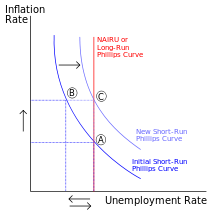Managerial economics
| Economics |
|---|
 Phillips curve graph, illustrating an economic principle |
|
|
| By application |
|
| Lists |
|
Managerial economics is the "application of the economic concepts and economic analysis to the problems of formulating rational managerial decisions".[1] It is sometimes referred to as business economics and is a branch of economics that applies microeconomic analysis to decision methods of businesses or other management units. As such, it bridges economic theory and economics in practice.[2] It draws heavily from quantitative techniques such as regression analysis, correlation and calculus.[3] If there is a unifying theme that runs through most of managerial economics, it is the attempt to optimize business decisions given the firm's objectives and given constraints imposed by scarcity, for example through the use of operations research, mathematical programming, game theory for strategic decisions,[4] and other computational methods.[5]
Managerial decision areas include:
- assessment of investible funds
- selecting business area
- choice of product
- determining optimum output
- sales promotion.
Almost any business decision can be analyzed with managerial economics techniques, but it is most commonly applied to:
- Risk analysis - various models are used to quantify risk and asymmetric information and to employ them in decision rules to manage risk.[6]
- Production analysis - microeconomic techniques are used to analyze production efficiency, optimum factor allocation, costs, economies of scale and to estimate the firm's cost function.
- Pricing analysis - microeconomic techniques are used to analyze various pricing decisions including transfer pricing, joint product pricing, price discrimination, price elasticity estimations, and choosing the optimum pricing method.
- Capital budgeting - Investment theory is used to examine a firm's capital purchasing decisions.[7]
At universities, the subject is taught primarily to advanced undergraduates and graduate business schools. It is approached as an integration subject. That is, it integrates many concepts from a wide variety of prerequisite courses. In many countries it is possible to read for a degree in Business Economics which often covers managerial economics, financial economics, game theory, business forecasting and industrial economics.
Scope
Managerial economics to a certain degree is prescriptive in nature as it suggests course of action to a managerial problem. Problems can be related to various departments in a firm like production, accounts, sales, etc.
- Demand decision.
- Production decision.
- Theory of exchange or price theory.
- All human economic activity.
Demand decision
Demand is the willingness of potential customers to buy a commodity. It defines the market size for a commodity, and at a disaggregated level the composition of the customer base. Analysis of demand is important for a firm as its revenue, profits, and income of its employees depend on it.[8]
See also
Notes
- ↑ W. B. Allen, , 2009. Managerial Economics Theory, Applications, and Cases, 7th Edition. Norton. Contents.
- ↑ • William J. Baumol (1961). "What Can Economic Theory Contribute to Managerial Economics?," American Economic Review, 51(2), pp. 142-46. Abstract.
• Ivan Png and Dale Lehman (2007, 3rd ed.). Managerial Economics. Wiley. Description and chapter-preview links.
• M. L. Trivedi (2002). Managerial Economics: Theory & Applications, 2nd ed., Tata McGraw-Hill. Chapter-preview links. - ↑ NA (2009). "managerial economics," Encyclopedia Britannica. Cached online entry.
- ↑ • Carl Shapiro (1989). "The Theory of Business Strategy," RAND Journal of Economics, 20(1), pp. 125-137.
• Thomas J. Webster (2003). Managerial Economics: Theory and Practice, ch. 13 & 14, Academic Press. Description. - ↑ For a journal on the last subject, see Computational Economics, including an Aims & Scope link.
- ↑ • James O. Berger (2008)."statistical decision theory," The New Palgrave Dictionary of Economics, 2nd Edition. Abstract.
• Keisuke Hirano (2008). "decision theory in econometrics," The New Palgrave Dictionary of Economics, 2nd Edition. Abstract.
• Vassilis A. Hajivassiliou (2008). "computational methods in econometrics," The New Palgrave Dictionary of Economics, 2nd Edition. Abstract. - ↑ • Trefor Jones (2004). Business Economics and Managerial Decision Making, Wiley. Description and chapter-preview links.
• Nick Wilkinson (2005). Managerial Economics: A Problem-Solving Approach, Cambridge University Press. Description and preview.
• Maria Moschandreas (2000). Business Economics, 2nd Edition, Thompson Learning. Description and chapter-preview links. - ↑ Prof. M.S. BHAT, and mk RAU.Managerial economic and financial analysis.Hyderabad.ISBN 978-81-7800-153-1
References
- Alan Hughes (1987). "managerial capitalism," The New Palgrave: A Dictionary of Economics, v. 3, pp. 293–96.
- Edward Lazear (2008). "personnel economics," The New Palgrave Dictionary of Economics. 2nd Edition. Abstract.
- Keith Weigelt (2006). Managerial Economics
- Elmer G. Wiens The Public Firm with Managerial Incentives
- Khan Ahsan (2014). "Managerial Economics and Economic Analysis", 3rd edition, Pakistan.
- arya sri."managerial economics " :MEFA . (2015).
Journals
- Computational Economics. Aims and scope.
- International Journal of Economics and Management Sciences
- Journal of Economics & Management Strategy. Aims and scope.
- Managerial and Decision Economics
External links
1. http://www.edushareonline.in/Management/eco%20new.pdf 2.http://www.swlearning.com/economics/hirschey/managerial_econ/chap01.pdf